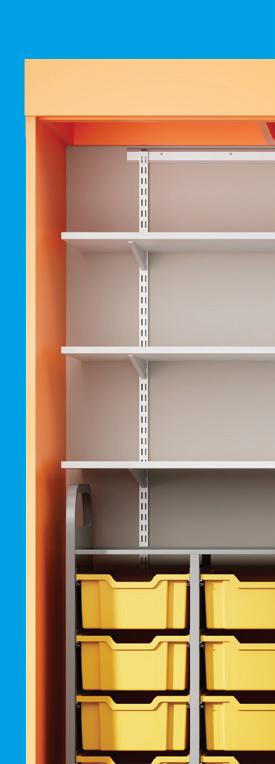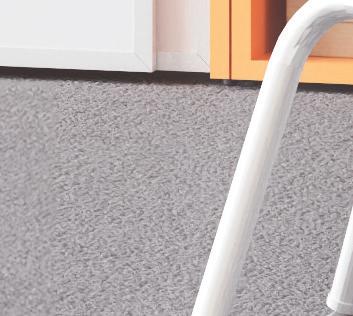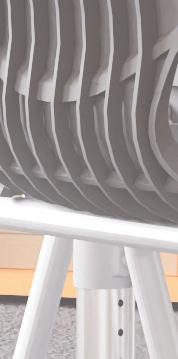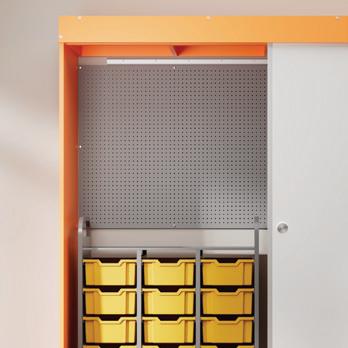
Spark curiosity. Ignite learning.






Spark curiosity. Ignite learning.









Educational spaces are more than just physical locations for learning; they’re the foundation on which we build the future. This starts with attracting and retaining the best educators by offering spaces that align with their goals, reflect their values, and enhance their efforts. Creating a place where teachers and librarians want to be makes them more likely to stay and thrive, which benefits your entire community.
Encouraging school pride is an essential element in creating this vibrant learning environment. A well-designed classroom can become a beacon of learning and inspiration, fostering a sense of ownership among students and staff. When educators and kids are proud of their surroundings, it positively impacts their motivation and interest.
In this issue of the Demco Array, you’ll find practical tips for maximizing your classroom’s potential, strategies for creating inclusive and engaging spaces, insights into the latest innovations in educational design, and more. This one’s for all the dedicated educators who are fostering dynamic and equitable learning environments that encourage engagement. Thank you for all you do!

Chad Edwards, President
The Demco Array celebrates the role of librarians and pre-K–12 educators in our communities while sharing an array of ideas and inspiration to help you spark curiosity, ignite learning, and transform lives.

Looking for a teacher’s new favorite chair? Or planning to renovate an entire school? Our experts can help you find exactly what you need to transform the school year and your spaces — top to bottom!










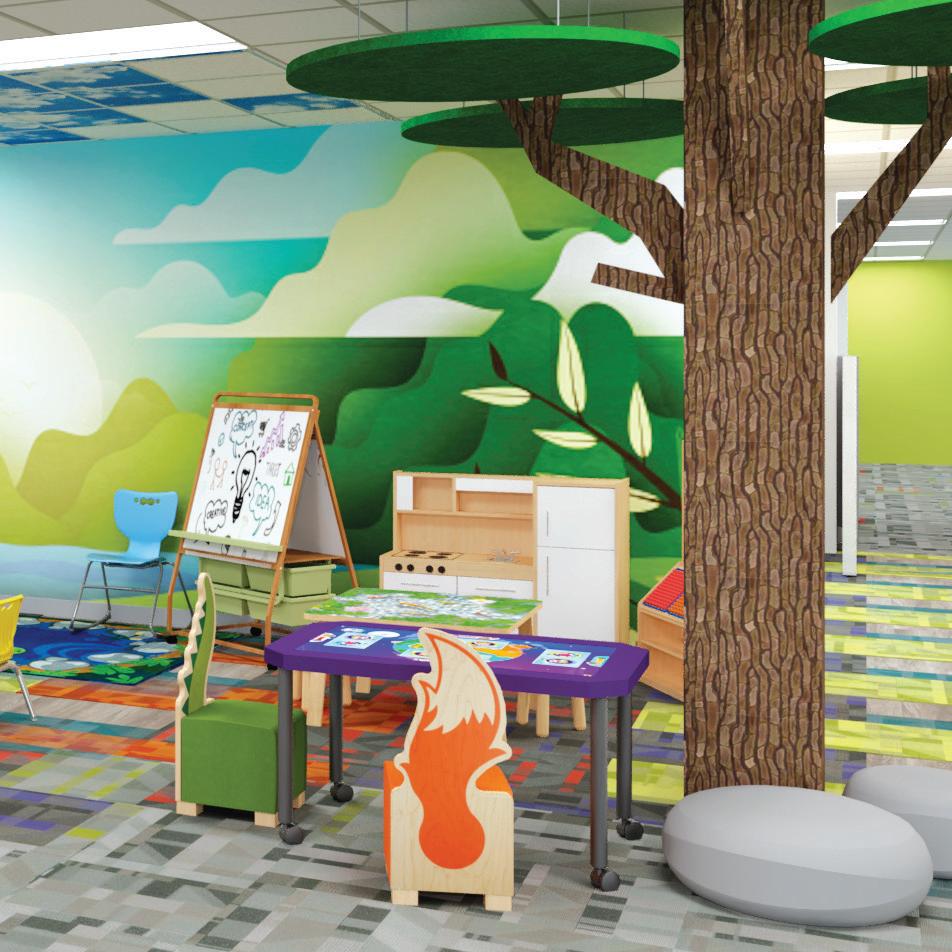
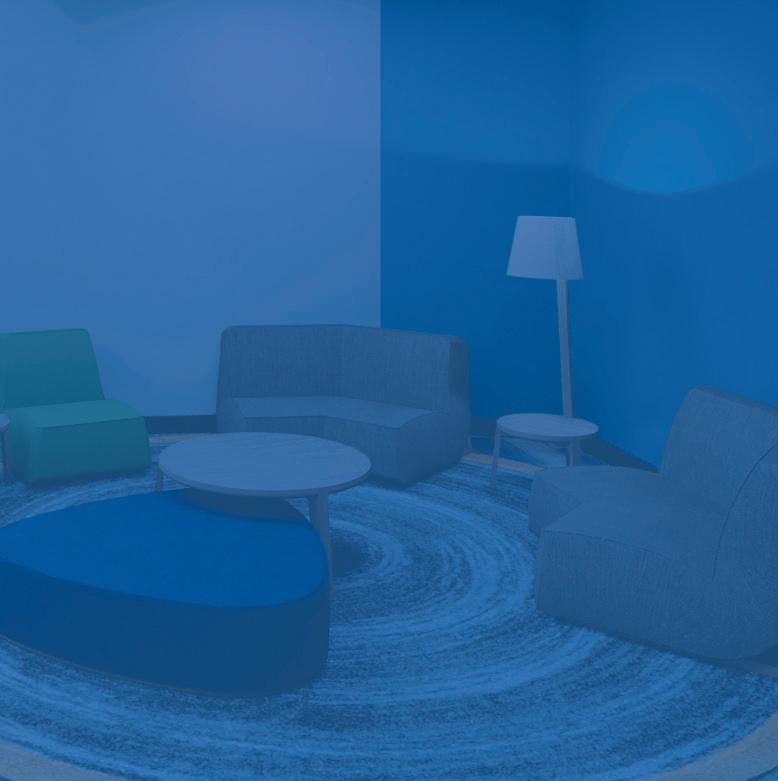

I could not have asked for a better designer, a more pleasing installation process, or higher quality furniture.”
Morris
Lyon, Superintendent, Hawkins Independent School District (TX)






We o er a wide range of exclusive, future-focused learning environment solutions. Plus, our partners include top national furniture brands whose commitment to exceptional quality and customer care matches our own. So, you’ll have access to a broad network of trusted suppliers as well as our Demco-exclusive o erings!

















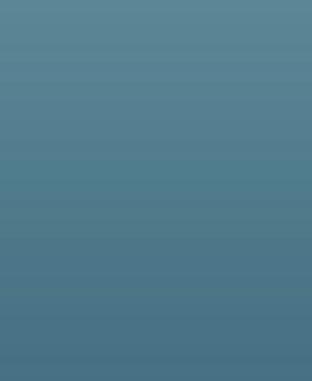

By Kate Larson and Demco
Raise awareness around teacher burnout and collaborative teaching.






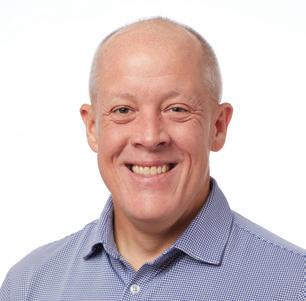
Dr. Robert Dillon
Author, Speaker, Educator
With 20+ years in the education space, Dr. Dillon has served as a teacher, principal, technology director, and innovation leader. Working through an equity lens, he looks to bring excellence to every classroom.

Kate
Larson
Writer, Researcher
Kate has a background in non-profit communications and is particularly interested in the ways that language drives behavior changes through education, awareness-building, and the power of an irresistible narrative.

Dr. Eric Runez K–12
Project Director, Educator
A former Wisconsin principal and school district superintendent, Dr. Runez is currently a K–12 Project Director for McKinstry, a national construction and energy services company. His work in the public and private sectors gives him a unique perspective on partnership, communication, and innovation.

Amy Uelmen
Director of Instructional Technology, Educator
As the Director of Instructional Technology at Pulaski Community School District in Pulaski, WI, Amy believes a technology-rich environment motivates students, positively impacts achievement, and creates learning experiences. She enjoys sharing her enthusiasm for integrating technology with others.







By Demco
Hear what it’s like to update a space firsthand from a former superintendent.
By Kate Larson
Make school a place that your students and their families embrace.
By Demco
Help provide every learner with the same opportunities for success.
By Dr. Robert Dillon
Explore the connection between well-designed spaces and your priorities.















































































































































































































































By Kate Larson and Demco











































































































When teachers gain experience, see salary increases, and feel comfortable managing their workloads, their job satisfaction improves. Yet, a concerning number of teachers are still leaving the profession.
Nationwide, teacher retention remains an ongoing challenge. Schools and districts often struggle to fill important roles, with special education positions being among the hardest to fill. While teacher shortages predate the pandemic, shortages have since grown and expanded to other important non-teacher positions such as bus drivers, school nurses, food service workers, and more.
According to new data from Education Week, teachers with three to nine years of classroom experience have worse morale than their peers with either more or less experience. They’re also less likely than teachers in other stages of their careers to say they’d recommend pursuing a career in teaching.


Even after administrators successfully fill these positions, they face the challenging task of maintaining morale after the initial optimism and excitement fades.



Create a culture of teacher appreciation, reminding teachers frequently that they see their efforts and are grateful for everything they bring to their jobs.
The frequent, unpredictable changes to schooling since spring of 2020 have left teachers exhausted and cynical. Even though school conditions are back to normal, teaching is more complex and demanding. Everyone is working to fill in gaps in students’ academic instruction, social and emotional learning (SEL), and classroom readiness — but the school day hasn’t gotten longer and resources are stretched too thin, especially in low-income districts.
Burnout can be contagious, and working in a school where the teaching staff and administration struggle to stay motivated creates a recipe for feeling overwhelmed.
In addition, many teachers feel unappreciated and demoralized by public conflict about the educational system. In California, 64% of surveyed educators said school board meetings had become increasingly contentious and political, 72% said they felt demoralized by public conflicts, and 60% said they were worried about their professional discretion in teaching certain issues and selecting curriculum.
Collaborative teaching is a winning strategy that positively impacts students, teachers, and the entire school community — and classroom design is a key element in its success. Here are some ideas for designing a space that will work best for your team!
Make a communal workspace to plan, share materials, and debrief. Include a table with storage for lesson plans and supplies, multiple chairs, standing desks, whiteboards, or bulletin boards. This lets teachers stay actively involved in lessons and fosters a sense of partnership.

To address these growing concerns from teachers, administrators can:
• Create a culture of teacher appreciation , reminding teachers frequently that they see their efforts and are grateful for everything they bring to their jobs.
• Support teachers with clear policies and practices around work/life balance . Do what’s possible to provide a level of support staff who can free up teachers to focus on their classes.
• Consider using staff days as catch-up days rather than planning more programming.
Flexible furniture allows for group work, wholeclass instruction, or breakout sessions as needed. Choose easy-to-rearrange tables and chairs that suit different teaching (and learning) styles.
Embrace a multifunctional space and dedicate sections of the classroom to specific strengths. For example, a designated lecture-style teacher area may have rows of chairs, while a small group discussion area may have a carpet with comfy seating.
Ensure there’s space for students to work in groups. Include round tables, beanbags, or even a collaboration corner.
Teachers need to know that their administration has their backs, whether communicated via teacher appreciation efforts, filling vacancies to address staffing shortages, or administrators jumping in to substitute in classrooms to protect teachers’ break time.
A classroom environment affects a teacher’s belief in their ability to do their job well. Something as simple as classroom lighting, clutter, or wall decor can play a role in whether teachers feel adept and confident. That confidence is what researchers refer to as a sense of efficacy: how well teachers think they can engage students, manage their classroom, and help their students learn.
Measuring teachers’ sense of efficacy is different from rating their effectiveness or tracking their students’ performance; it gets straight to the center of how teachers assess and evaluate themselves and how that shapes their approach to the classroom.
Does a teacher feel that they can foster student creativity? What about calming disruptive students or adjusting lessons to meet individual student needs?
Measuring teacher efficacy can provide a fascinating window into how teachers view their skills/abilities and add a crucial data point to the conversation about how various environments and situations affect teachers.
Teacher efficacy is correlated with teachers’ persistence, enthusiasm, and commitment — all factors that affect their performance and (no surprise!) can benefit their students, too.
When teachers feel like they’re able to teach well, they do. That feeling creates job fulfillment.
PROVIDE SELF-CARE OPPORTUNITIES
To maintain a sense of balance, teachers also need time to unwind
and do the things they love outside of teaching (which means that grading, lesson prep, and other at-home activities can’t consume every waking moment).
Research shows that self-care for teachers is linked to greater accomplishment and lower exhaustion, which suggests that it plays a role in helping to avoid burnout. Administrators can work to ensure that teachers aren’t filling in so many roles that they don’t have any time left for themselves — which may mean hiring extra staff.
Teachers need support from their administrators. As schools and districts struggle with staffing shortages, it’s crucial administrators do what they can to prevent burnout, empower teachers in their classrooms, and provide self-care opportunities.
A great teacher makes a real difference in so many lives, and providing meaningful support from the administrator level is the key to ensuring teachers feel confident, empowered, and successful in their positions, not just during the first few years of teaching, but throughout their careers.
as
When it comes to fostering collaborative teaching, an investment in design supports teachers and creates a more engaging learning experience for students. Here's how you can help champion classroom design.
1 2 3 4 5 6
Allocate a portion of the school budget to furniture and equipment that supports flexible learning spaces.
Explore and advocate for innovative furniture solutions that promote movement and interaction.
Work with teachers to identify opportunities to create designated zones for di erent learning activities within existing classroom spaces.
Invest in technology that supports teamwork.
Incorporate classroom design considerations into discussions on pedagogy and curriculum development.
Showcase classrooms that exemplify successful collaborative teaching design.













Scan to shop the full FLEXplore Collection

















It’s okay to show o the FLEXplore Collection a bit. A er all, it uses the genius of geometry to create dynamic arrangements anywhere and pairs perfectly with ergonomic Tidal Seating.











Scan to shop the full Tidal Seating Collection
Dr. Eric Runez is a K–12 Project Director for McKinstry, a national construction and energy services company dedicated to engineering and designing environmentally friendly buildings and building systems. Before working in the private sector, he spent more than 10 years in the Wisconsin public school system as a superintendent. His work in both the public and private sectors gives him a unique perspective on the importance of partnership, communication, and innovation to empower schools with learning environments that help students maximize their potential. Read on to see what Eric has to say about his experiences and what advice he has for school districts.

How does your background as a superintendent play into your current role at McKinstry?
As a Wisconsin superintendent, I had a lot of experience with both capital and operational referendums. I obviously paid a lot of attention to student achievement and the instructional side of the house. But I also had a lot of responsibilities related to operations, learning environments, and facilities. Those experiences supported my transition into the private sector. In my current role at McKinstry, I support the K–12 market sector in the Midwest. McKinstry is a building solutions company, and our services range from construction projects, energy efficiency projects, and sustainability projects to strategic facility long-range planning.
What do you enjoy about your current role as a K–12 Project Director and what did you enjoy in your previous role as a superintendent?
Q A Q A Q Q A A
I absolutely loved superintendency. I really enjoyed the problem-solving aspect of the role — figuring out how to improve learning environments, instructional practices, and educational experiences for our students. I enjoyed supporting our instructional staff and our classified staff, building a great culture for our students, and supporting the community.
I enjoyed engaging with the community — making sure they understood the investments they were making in their school systems for the benefit of the children and sharing out the successes.
In the private sector, a lot of what I do is more on the operational side. But I’m enjoying similar problem-solving experiences. I particularly enjoy bringing solutions around school facilities operations and getting to support the next generation of superintendents and school district administrators.
What does it mean to create a learning environment and why do you feel they're so important?
There are different aspects to a learning environment. There are the intangible pieces: the culture, the relationships between students, staff, and the greater community, and the experiences around that. And then there are the tangible pieces of the learning environment: the furniture, aesthetics, air quality, temperature, and lighting. It all contributes to a positive learning environment and to student success.
What do you feel are the critical components of a learning environment?
As far as tangible aspects of learning environments that support modern instructional practices, I ask fundamental
questions. Is the learning environment flexible to adapt to the instructional needs of that lesson or that day? Is it warm and inviting? Is student comfort taken into account?
When considering comfort, that could be the furniture, but also temperature, air quality, or lighting. Air quality can contribute to students feeling tired. Poor lighting makes learning more difficult. Uncomfortable furniture or unwelcoming room aesthetics can negatively affect the educational experience. These are integral components to helping students access the curriculum. They all factor into the quality of the instruction, too. If teachers feel like they have a great place to work and to provide learning for students, that contributes to a positive learning environment and a positive working environment.
QQ Q Q A A A
What advice do you have for school districts facing growth or in need of funding for a large project?
School districts often can’t cover increasing costs for improvements or renovations within their annual operational budget. So, districts must go to their communities and ask for a bond to exceed the levy to increase their operational budget for a one-time capital improvement. In my experience, it’s essential to engage your community. You have a wide range of community members who utilize your facilities, including community members who don't have students in the school system anymore, or never did. You want municipality representation, business leaders, clergy, etc. And you want to involve them as early as possible and gain an understanding of what they value about the school system. You also want to help the school district prioritize any additional resources they may get. It’s a comprehensive and thoughtful approach.
From a superintendent’s perspective, what can a construction partner like McKinstry bring to the table that makes you want to work with them?
Good capital improvement partners (and that can be general contractors, architects, or a learning environments company like Demco) are ones that make communication easy. They’re readily accessible and they ask good questions. They don’t come in with predetermined solutions. Once they’ve identified the pathway for solutions, there’s a willingness to continue to refine and improve it as new information or perspectives become available. They communicate well, listen well, and want to build a good foundation for a long-term relationship.
From a construction perspective, how can school districts be the best partners for you?
They can be candid about their needs and be willing to facilitate processes that provide multiple perspectives and a variety of input and feedback. It’s helpful when districts are willing to be innovative and open to opportunities that might not be your traditional cookie-cutter approach.
What trends are you looking forward to in school construction?
A
We’re seeing several districts that are considering climate action plans. I'm really interested to see how that continues to evolve. How will schools approach future capital projects and capital improvements to be more sustainable, reduce their carbon output, and be better stewards of the environment? It’s an interesting pathway that's developing.












HOW TO TURN AN IDEA INTO A PRODUCT IN SEVEN NOT-SO-SIMPLE STEPS











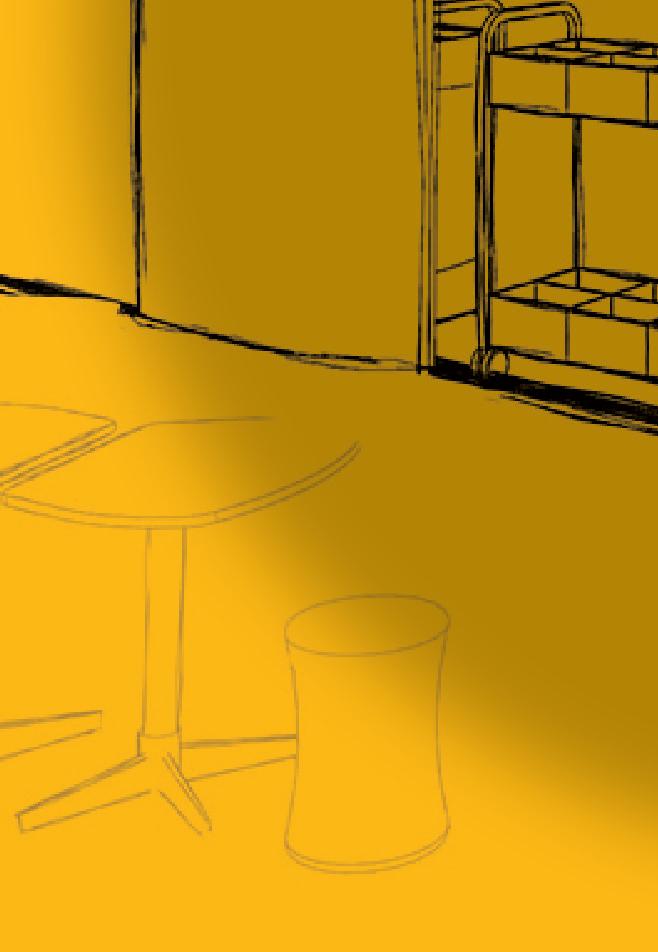



By Kate Larson






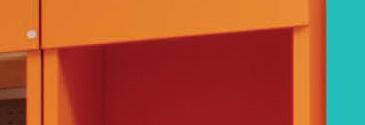







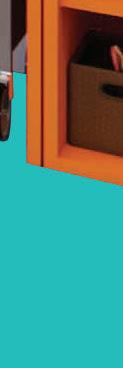







DO YOU EVER WONDER HOW THE CHAIR YOU ’ RE SITTING IN WAS DESIGNED?
Who decided its shape and size? Who developed its functionality (does it spin or recline?) and chose its materials and color scheme? Out of all the chairs available, somehow this one made its way to where you’re sitting.
Ideally, a chair fits within the space, suits the room’s overall aesthetics, and suits your individual needs. It should also feel comfortable and support your body well.
“Design development is always a balance between meeting multiple criteria,” notes Stephen Gower, Demco Design Supervisor. “We want a product that’s … stable, strong, and durable, but we also want it to be manufacturable at a good price point, so the customer finds value in it.”
This balance requires time, creativity, and a deep understanding of the end users: the librarians, patrons, teachers, and students who will interact with a product. “It takes us a while to identify when there's a problem versus [developing] the solution and then getting it to launch,” explains Demco Senior Product Innovation Manager Kaitlin Reese. “It doesn't happen overnight.”
The design innovation process involves multiple stages, many creative minds, and countless rounds of testing and refining. Here are seven steps that any new Demco product must go through before it’s ready to launch.
the on-the-ground perspective of customers whose needs aren’t currently being met. “We have representatives all across the country who are talking to our customers every single day,” she says. “It’s nice to hear their feedback and ask more questions to say, ‘All right, what’s the real problem? What are we trying to solve for?’”
The best way to find problems that need solving is to listen and observe.”
—Kaitlin Reese, Senior Product Innovation Manager

“The best way to find problems that need solving is to listen and observe,” Reese says. “I try to visit as many schools and libraries as I can.” Demco also benefits from
Demco designers attend trade shows to immerse themselves in product design trends, new materials, and manufacturing techniques, Gower says, creating “a multifaceted stream of information coming in.” Once the team identifies a gap in the market, “we'll go through a robust, ground-up process of understanding the need,” he says, “refining what that need is and working with other customers to confirm that we have defined it well.”
Before designing a solution, the product team needs a thorough understanding of the problem and the market. “[We do] industry research to see: What are other companies doing to solve this problem?” Reese says. “Are they doing anything? And how can we understand how marketable this is?”
For example, Reese says research revealed a crucial gap in the market for adaptable furniture. While existing desks could be joined together to create a five-person circle, none of them supported left-handed students. “So, we brought this question forward,”
Continued on page 15 >>

















Create a vibrant, whimsical space that encourages kids to explore, imagine, and grow



















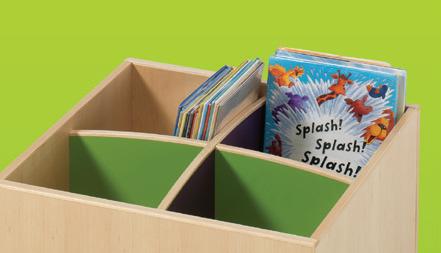


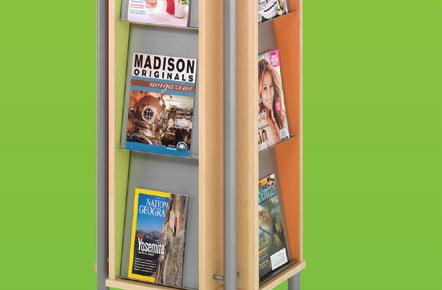








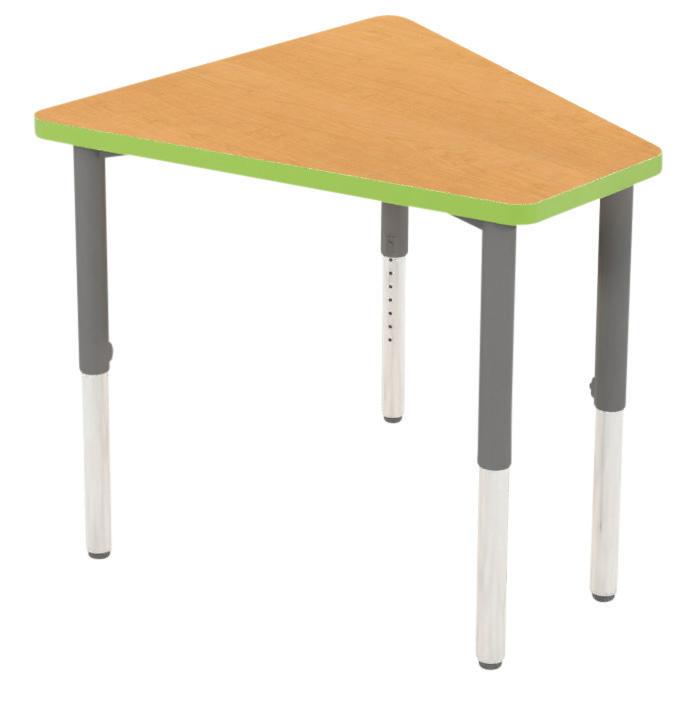
she explains. “Can we create a desktop shape that could be left- and right-handed, but also create a five-person circle?” That line of inquiry led to the development of the FLEXplore Share Desk. “We wanted to make it all-inclusive, so every student can sit here,” Reese notes, “creating a space that is going to represent and be useful for all of our students.”
With research in hand, the product design team begins to visualize what the final product might look like. “Hand sketching is the first step and then we move into 3D,” Gower says. “We have computer-aided programs that help us create design iterations quite quickly.” Creating a 3D model, he explains, gives the team “a conceptual rendering that could capture the feel of an idea at a very high level.” These renderings can also be easily shared across the various teams involved in the product development process. At this point, the design will move through many versions as designers ask: ‘Does this work? What would make it better?’
solutions — “something that can blend in, but also still be beneficial to that space,” Reese says. Although the products, made partly from recycled plastic bottles, sounded like a good idea, Reese says she wasn’t sure how well they would mesh with other aspects of Demco’s space design. “But then when you see them in the renderings and you see them in the spaces, they really pop,” she says.
Once design options have been narrowed down, the design and product teams collaborate to keep honing the future product’s aesthetics, function, and feasibility. The designs also circulate to the materials management team, which works to “make it engineerable — make sure that we can actually produce this product,” Reese says.
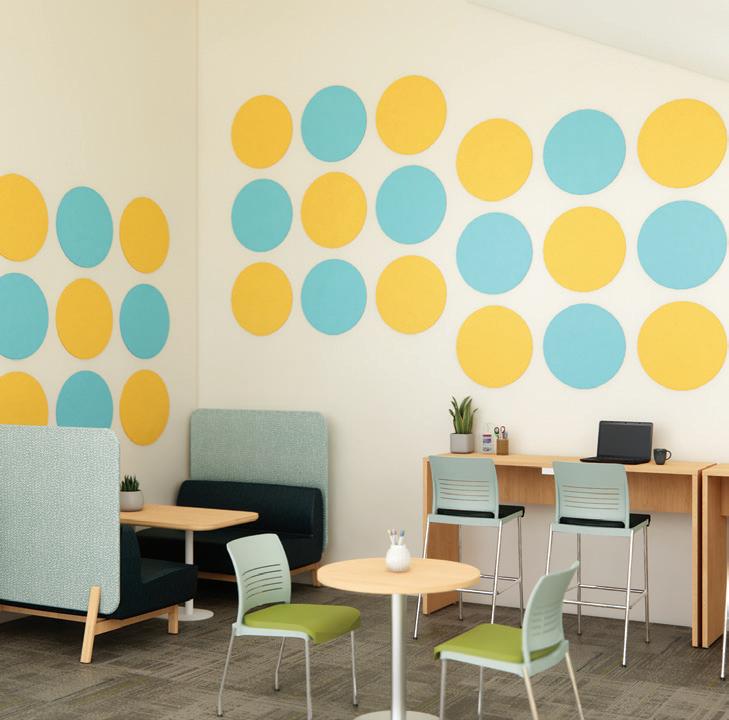
One concept that came to life in virtual renderings was Demco’s CalmScape Acoustic Collection. The pieces solve a tricky problem: libraries and classrooms need to support both lively collaboration and quiet focus. The resulting line of sound-absorbing tiles can be wallmounted or hung, and they’re designed to be “more aesthetically pleasing” than other acoustic
At this point, the design is ready for prototyping. Demco’s manufacturing facility produces to-scale models of the product that can be tested for functionality and eventually put into the field for user feedback. “We all work handin-hand to get those prototypes made and make sure that they're made up to our specs,” Reese notes.
The process of building and testing prototypes exposes areas of the design that need refinement. “Once we get a prototype in,” Reese says, “[the teams] review the prototypes, make sure that






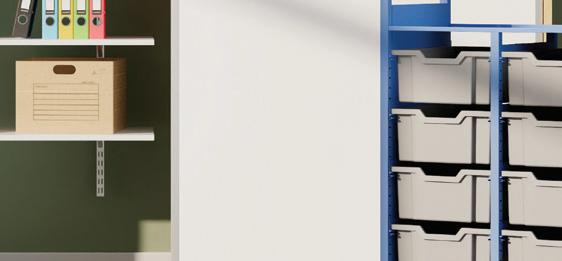

One influences the other. You can’t design a space without a product, and you can’t design a product without understanding the space.”
—Stephen Gower, Demco Design Manager




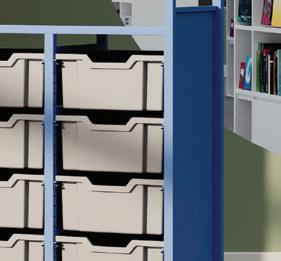


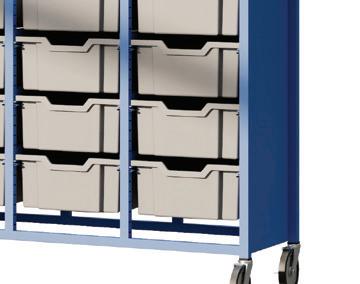






they’re what we’re looking for, identify problems, identify solutions, and work through any design changes that are needed.” This is also where engineers work to design efficient manufacturing processes that lower the cost of production. “We want to make sure that they’re quality products, they’re going to withstand the test of time — but hoping that we can get their dollar to stretch further,” Reese says. “We really understand that those dollars matter so much to our schools and libraries.”
Putting prototypes into the physical spaces where they will be used (classrooms, common areas, libraries) and asking end users to try them out provides valuable information that helps sharpen the final design, Gower says. “How products work in spaces, I think, is where Demco has a real vibrancy and uniqueness,” he explains. “One influences the other. You can’t design a space without a product, and you can't design a product without understanding the space.”
Once the design is finalized and the manufacturing process is set, the new product (or line) is ready for production! No longer simply an idea, a drawing, a 3D model, or a rough prototype, it’s a finished piece, ready to be installed and enjoyed. At this point, Reese says, the product team ensures that the marketing and sales teams are ready to “really tell the story that we're trying to tell — the problem that we’re trying to solve or the solution that we have — so that they can articulate that to our customers.”
One product Reese says she found particularly exciting to launch was the Show & Stow storage line. It solved a pressing need. “There’s a lot of things that classrooms and libraries need to have, but because there are so many materials in those spaces, they can become overwhelming and overstimulating.” Through the design process, Demco developed a flexible solution that combines shelving with configurable storage carts, housed within an exterior closet with sliding, dry-erase doors that minimize distraction and function as a work surface. “It’s a nice way for teachers to bring out the materials when they need them, roll them around the classroom or library,” she says, “and then when they’re done, you tuck them away, close the doors, and you can’t see it. And so it’s no longer a detraction from the space.”
Innovation is an ongoing process. “My idea list is never-ending,” Reese says. “I could have that list running forever. Because we continually get feedback — from our customers, from our representatives — of things that they need in the market.” As she works to develop a road map of new product innovation, she says the key is “identifying what those problems are and then prioritizing the ones that we feel will be most impactful to our customers.”
Gower notes that for Demco, the purpose of innovating new products is always to support lifelong learning. “[In this] industry, we’re all looking to achieve the same thing,” he says, “which is to make the learning experience as engaging and as vibrant and as valuable to students as it can be.”
By Kate Larson
There’s nothing better than a wave of excited students filling your classrooms and hallways at the beginning of a school year. But how can we maintain that sense of excitement through June — including the January doldrums and end-ofthe-year chaos? By nurturing students’ sense of school pride and the feeling that they are part of a community they want to belong to.
School pride isn’t just the product of dressing up in school colors or doing a crazy hair day (although those can be fun ways to boost engagement). While these things are a part of creating a positive school culture, fostering true pride in the school community takes commitment and effort from administrators, educators, and staff. This commitment couldn’t be more important. In a 2014 survey, American high school principals overwhelmingly cited school spirit as a key factor for student success, both inside and outside the classroom. More than 90% of principals said that students with high levels of school pride were more confident and more likely
to be school leaders. When their students were surveyed, those who reported high levels of school spirit were significantly more likely to outperform their peers academically. In addition to this fact, a recent article by The New York Times reported that chronic absenteeism was on the rise over the last few years. According to the article, an estimated 26% of public school students were considered chronically absent last school year, up from 15% before the pandemic. While there are many factors that contribute to this unsettling trend, boosting school pride and student engagement can be a powerful way to address the issue or even reverse the trend entirely.
One student told researchers that “school spirit means supporting your school no matter what and taking pride in your achievements, knowing your school has helped you to reach your goals.” So how do we inspire students to feel proud of their school in this way?
THREE STRATEGIES TO boost pride and morale
One potentially surprising way to boost school pride is to build relationships with the members of your school’s neighborhood and community. Invite local citizens who might want to spend time in a classroom explaining their careers or host a job-shadowing day for older students. Encourage your students to research the history of their town or city and reach out to the local historical society or local government leaders. Find ways to link young students with retirees to form cross-generational learning partnerships. Research shows that strong parent-community-school ties help schools improve student achievement and are a great way to get your students excited about representing their school to the community at large.
Alternately, challenge graduating students to establish a community gift from the school. Interview residents to determine what the neighborhood might need and where they might need it. Public art, benches, or playground updates are a good place to start. Students can work with residents to poll, vote, and select a project that’s followed by fundraising and donated work days. Giving back to the community in the name of the school sets a precedent for future students and establishes a strong relationship.
School spirit means supporting your school no matter what and taking pride in your achievements, knowing your school has helped you to reach your goals.”
—Student, Varsity Brands Study
To get started, consider a crowdsourced project for the entire school. Create a community resource map while individual classrooms brainstorm lists of people, organizations, and local groups who might have something to offer the learning community. These can be assembled to create a school-wide resource (an actual map, a spreadsheet, or some other visual representation of the many people and groups who support your learners). Now you have a tool for building community relationships as well as students who are eager to start making connections.
Walking into a freshly painted lobby, sinking into a cozy reading nook in a redesigned school library, or catching a glimpse of recent student artwork in a gleaming display case are experiences that inspire a visceral sense of delight in any learning environment. Students can tell when facilities are being maintained and cared for, as well as when their teachers have spent those precious last few days of the summer organizing and decorating their classrooms in anticipation of the newest crop of learners. In fact, studies show that the school environment has a huge impact on student well-being. Beyond creating a bright and inviting space, you can also use minor building upgrades to create a distinctive visual identity for your school.
Your school logo, motto, values, and colors can all be used as design elements to cultivate a sense of kinship and
More than 90% of principals said that students with high levels of school pride were more confident and more likely to be school leaders.
—Varsity Brands Study
belonging among students. This can be as ad hoc as teachers decorating their classroom doors or as coordinated as a full-scale renovation, depending on existing needs and available resources. On top of decor, school furniture can either signal to students that they fit (literally, in the case of chair and table height) or they don’t. Seating options can invite collaboration, creativity, and comfort or can unwittingly become a constraint to learning.
When it comes to wall space, start to think about how you can use yours to promote a sense of student pride by displaying student work, highlighting students who are great community members, and honoring educators for their dedication. By making your physical space a reflection of how much the faculty and staff care about the school, you can inspire your students to be equally passionate.
Educators and administrators lead the way in modeling school pride, but teachers’ overall happiness and mental well-being are also important components in shaping students’ feelings about their school. Teacher burnout can not only threaten teachers’ ability to stay in the profession (55% of educators told the NEA in February that they were considering leaving earlier than planned), but also harm student engagement. In fact, research shows that students’ perception of their teachers’ happiness strongly correlates with student attitudes and motivation. Not only that, but when teachers have better
mental well-being, their students score higher on overall well-being and lower on psychological distress. In other words, students thrive when their teachers are thriving.
So how can administrators support teachers’ mental health? Make sure there are clear protocols for how to handle challenging student behavior, including how and when to involve school mental health services and/or administrators. Keep the lines of communication open between the administration and teaching staff so you can identify and address teacher pain points as they arise. Make sure that educators have time, both during the day and outside of school hours, to unwind and engage in activities that help them de-stress.
Connecting students more deeply with their learning spaces, the wider community, and their teachers is a recipe for a student body that takes ownership of their school and their individual accomplishments. One high school principal told researchers that school spirit is a “sense of community with students, parents, teachers, and administrators working together with a common purpose and with activities for all segments of the school population.”
Here is one final question: as you approach the beginning of every school year, how will you work together with your students to find that common purpose?


Reduce noise levels while adding personality and a decorative touch to any space.














Choose from five unique designs and two sizes!









Set learners up for success with sound-dampening solutions. Reducing ambient noise can alleviate stress and fatigue, boost concentration, and create a teamwork-ready environment.
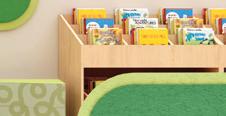
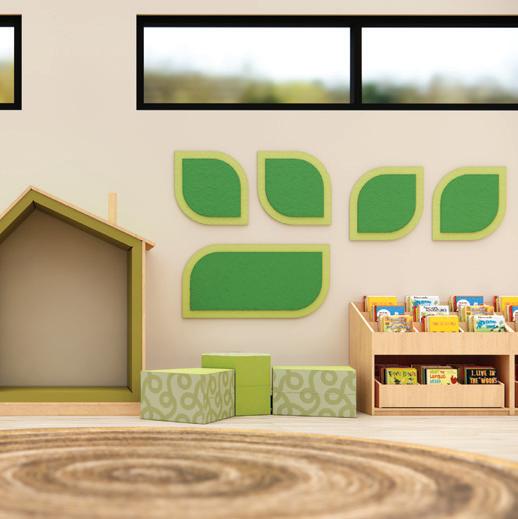

























By Demco
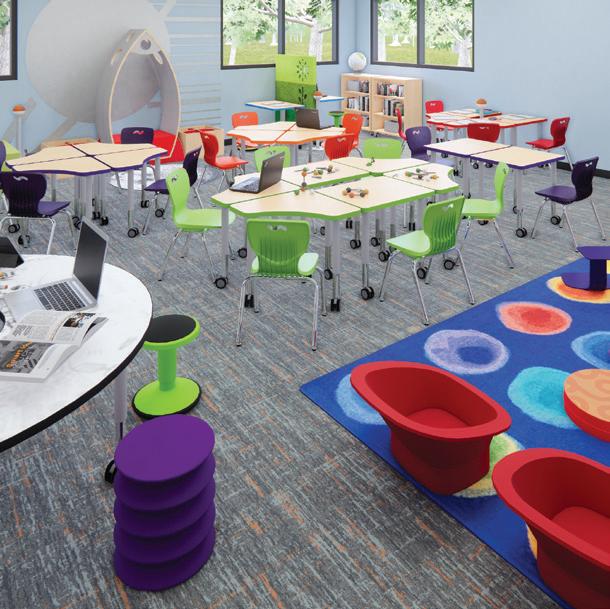

In today’s educational landscape, fostering equity in learning environments is a crucial goal for every school and library. Equity means more than just accessibility; it means ensuring that all kids, regardless of their background or abilities, have the same opportunities for success. Achieving this success requires a multifaceted approach that addresses various aspects of the learning
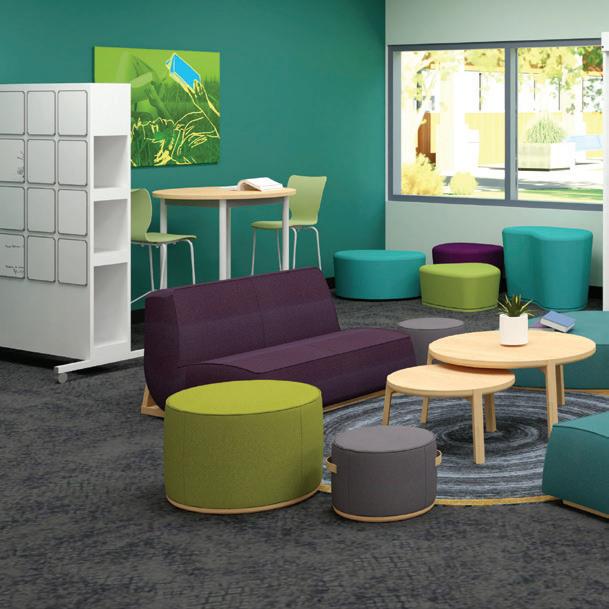
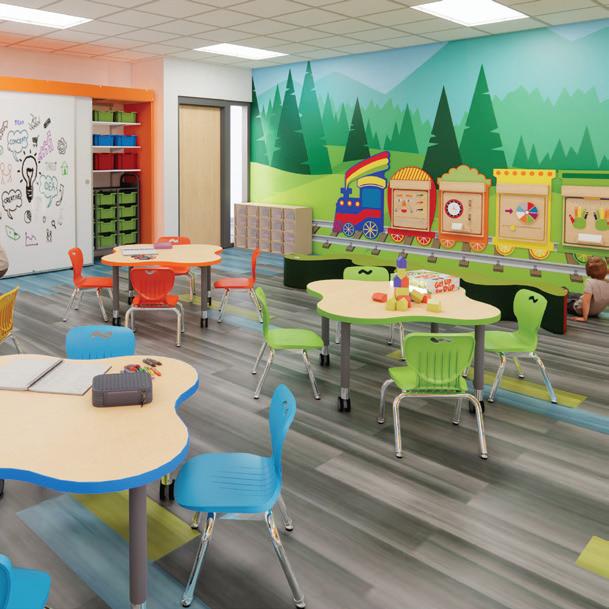
environment — from physical spaces to teaching methodologies.
In this article, we explore how prioritizing classroom acoustics, adding active seating, providing sensory and calming areas, and implementing ADAcompliant solutions can help create learning environments that empower everyone.

Often overlooked, poor classroom acoustics impede learning, making it difficult for kids to concentrate and understand others — especially those with learning disabilities like ADHD, auditory processing disorders, and kids who are learning English as a second language. In addition, background noise like loud HVAC systems, lawnmowers outside, and passing traffic can add to the distractions.
These challenges in learning are further explored in a study done by Speech-Language & Auditory Canada in 2019. It states that “noise and poor reverberation adversely affect typical young children more than typical adults. These factors, in addition to the inherent high demands on listening and auditory processing in classrooms and the immature listening skill of children due to neuromaturation, create barriers to learning that place all children at educational risk.” Implementing acoustic solutions can help with these challenges and enhance the learning experience for everyone. This can include installing sound-absorbing decor such as acoustic panels or ceiling tiles to reduce noise levels or changing a classroom’s layout to better control sound. For example, arranging desks in clusters rather than rows can help minimize noise propagation. Another study done by Pam Millett at York University discussed the benefits of these types of changes by going on to say that “the minute or two saved in getting students’ attention, or providing an instruction only once instead of multiple times may seem inconsequential as an individual event, but over the course of a day, these minutes add up to significant time devoted to instruction rather than classroom management.”
In addition, technology can be leveraged to improve acoustics. Hearing assistance systems, such as FM
systems or loop systems, can amplify sound for kids who are hard of hearing, ensuring they can fully participate in classroom or library discussions and activities with their peers. A York University article highlights the importance of this technology by quoting a teacher who said, “There’s a big di erence between ‘side’ versus ‘size’ in geometry, but I have to use both word all the time and without [acoustic solutions] sometimes students had misunderstandings about things like that.”

Traditional classroom seating often fails to accommodate the diverse needs of kids. Sitting still for extended periods is challenging, and can lead to restlessness and decreased focus among kids. Active seating solutions, such as wobble stools, balance balls, or standing desks, provide kids with alternative options that promote movement and engagement.
By incorporating movement into a learning environment, educators create a more inclusive space. These diverse seating options allow kids to expend excess energy while remaining focused on learning. Additionally, active seating promotes better posture and core strength, benefiting kids' physical health. An article from Learning Environments Research supports this ideology by describing how “students who experience flexible furniture reported greater satisfaction with the learning environment than did peers with traditional furniture.”
It’s always essential to o er a variety of seating options to cater to di erent preferences and comfort levels for optimal learning. Some kids may prefer standing desks for certain tasks, while others may find balance balls more conducive to concentration. Flexibility in seating arrangements empowers kids to choose the option that works best for them, promoting autonomy and self-regulation.


SENSORY/CALMING AREAS: PROVIDING REST AND SUPPORT
For kids with sensory sensitivities or neurodiverse conditions such as autism spectrum disorder (ASD), traditional learning environments can be overwhelming. Bright lights, loud noises, and crowded spaces can trigger sensory overload, leading to anxiety and distress.
Bright lights, loud noises, and crowded spaces can trigger sensory overload, leading to anxiety and distress.
Creating sensory or calming areas within the school or library allows kids to take breaks and regulate their sensory experiences. These spaces provide a soothing environment with dim lighting, comfortable seating, and sensory tools like fidget toys or weighted blankets.
Sensory areas serve as retreats where kids can decompress and recharge before returning to the classroom. They provide essential support for kids who may need extra assistance in managing their sensory needs. Additionally, these spaces promote self-awareness and emotional regulation skills, empowering kids to advocate for their well-being.

THE RIGHT SPACE FOR YOUR KIDS’ NEEDS: ENSURING ACCESS FOR ALL
ADA-compliant solutions include modifications and accommodations to remove barriers to access. While all schools must meet minimum requirements (such as installing ramps and elevators for wheelchair accessibility, providing tactile signage for kids with visual impairments, and incorporating assistive listening devices for kids with hearing impairments), creating more equitable learning environments is an ongoing process. A thoughtful, holistic approach can help address the diverse needs of kids. And by implementing acoustic treatments, active seating, sensory areas, and a wider-range of ADA-compliant modifications, educators can cultivate inclusive spaces where all kids feel valued and supported in their learning journey.





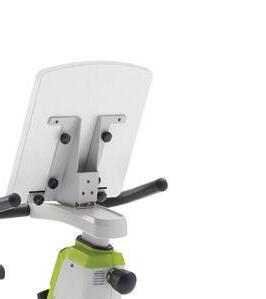

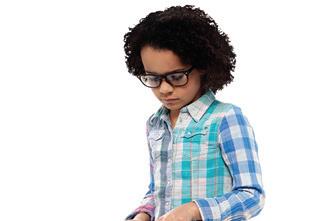



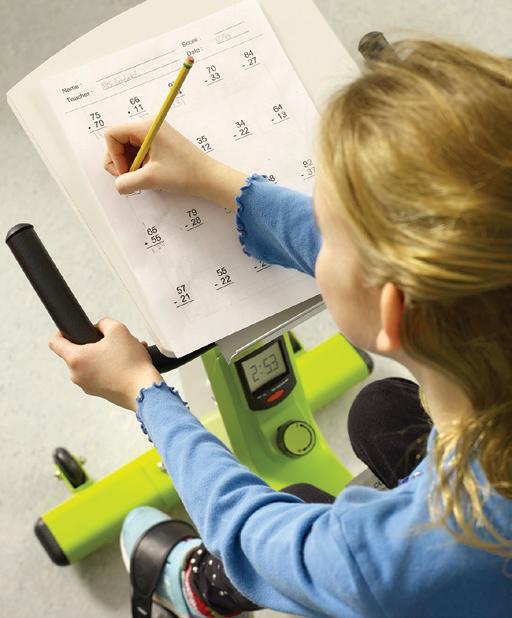
By Demco
According to new federal data, the average school building in the United States is nearly 50 years old. Despite this, numerous students and educators still call these buildings home in 2024.
Yet, instruction and teaching strategies have shifted. From the introduction of 1:1 devices and evolving edtech in classrooms to designated learning stations and collaborative spaces in libraries, how learners interact with their environments has changed — and continues to change.
An environment shouldn’t constrict learning. Instead, it should empower learners and support their growth.
Nationwide, libraries, schools, and entire school districts face challenges in making the most of their spaces to accommodate modern needs, and no two spaces are the same. From restrictive spaces and limited storage options to environments without windows or natural light, each space requires a thoughtful approach. Here are three common space challenges that often arise.
Between extra supplies, devices, coats, and more, storage is hard to come by in any space. At Oceanside Unified School District in Oceanside, CA, this exact challenge led community rooms in two of the school district’s elementary schools to become congested with boxes and other items over the years. While both spaces were created to provide a spot for school staff to visit with families, they became the go-to place for everything that didn’t have a home. Defining the goals of both spaces helped the Demco and Oceanside teams maximize the functionality of each room. Added storage along the
walls helped organize everything, while new chairs and tables in updated layouts helped prioritize face-to-face conversations. A win-win that didn’t require major changes at either school.
When co-creating and brainstorming ideas for a space, it’s important to remember that older buildings typically don’t have the insulation or sound-dampening properties newer buildings do. Poor acoustics can disrupt the learning process and affect speech perception, learner behavior, and even educational outcomes. While we can’t change the age or building materials of a space, implementing sound-absorbing decor can help. Incorporating soft surfaces such as carpets or creating zones with sound-dampening room dividers like those in Demco’s CalmScape Acoustic Collection can improve a space’s acoustics. And while soft surfaces can help with acoustics, hard surfaces can have the opposite effect. For example, at one school, leaders wanted tables and chairs with wheels to make it easy to move items between different classrooms (and even different schools). While the idea sounded great on paper, adding wheels changed the acoustics. With cement floors and high ceilings,


the wheels echoed across the space and made it difficult to hear others. Remaining flexible, the team adjusted their plans and made their space work without wheels.
especially true when working with an older building with limitations. Addressing each challenge is a thorough process and involves numerous stakeholders. It’s critical to consider input from all points of view and remain open to adjusting your original vision.
Plans will change. But remember that the end goal will remain the same: to create an environment that inspires and empowers.
to federal data on school buildings: 38% don’t have a STEM lab 11% don’t have a dedicated library space 31% don’t have a gymnasium 32% don’t have an all-purpose grass field




From simply refreshing a space to reshaping the look, feel, and flow of an entire building, changes big and small can be intimidating. Updating a space is much easier said than done, and that’s 12% 13% 13% 21% 21% were built before the 1950s were built after 2000 were built between 1970–1999 were built in the 1960s were built in the 1950s

























“The Average U.S. School Building Dates Back to the End of the Vietnam War” by Mark Lieberman, Education Week
The Restination Collection provides the ideal blend of comfortable designs and durable materials — making it easier than ever to create inviting spaces that foster collaboration.

Restination’s wide range of soft seating and tables are designed to be quickly reconfigured to work in any space. Restination also comes in a palette of inspiring colors and coordinates with other Demco collections for endless design possibilities.







+ Various seating styles (including rockers) offer a choice of comfort for every user

+ High-density foam cushions ensure a relaxing yet supportive place to sit and unwind
+ Modular components can be combined to suit any activity or space
+ Pieces coordinate with Demco ColorScape®, CalmScape, FLEXplore, and Tidal Collections








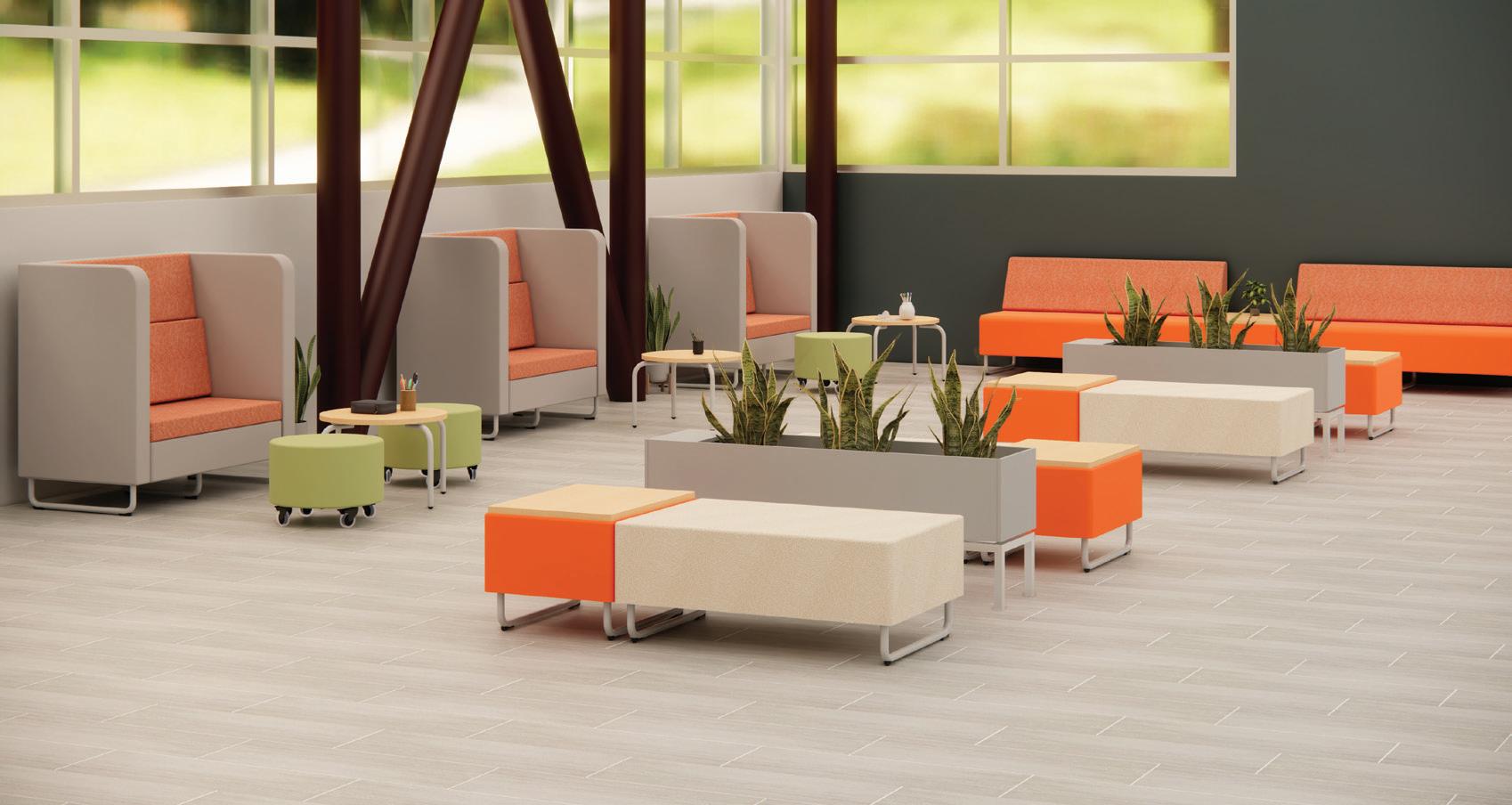









By Dr. Robert Dillon


Whether you are building a new school, adding onto an existing building, or remodeling and making the most of a current building, it is essential that you create explicit links between who you are and where you learn. The most effective schools craft visions, missions, and values that are alive — in that they feed the decision-making around all aspects of the school, including the physical design. Without this alignment, schools can actually create barriers to excellence. An apparent mismatch between what they say and the spaces they create can generate confusion about their true commitment to their vision and mission, discouraging buy-in from their communities.


that future school designs align with the district’s core principles while avoiding the most common potholes.


This doesn’t have to be the case, though. When thoughtfully designed, the physical spaces within a school can significantly enhance the educational experience, support the wellbeing of students, and foster a sense of belonging and connection. They can also be figurative ambassadors that speak loudly about the excellence of the work happening inside. Through this article, we hope to outline a process for ensuring
The first step in any design project should be to articulate the district’s vision, mission, and values clearly. So many schools and districts think that their mission statements are clear, but in reality, many audiences don’t have a sense of their real meaning and message. They are missing context, making it impossible to align design decisions to these statements of core principles without a shared understanding of what they truly mean. In clarifying, make sure that the long-term goals of the educational experience you want to provide (as well as the instructional strategies to unlock that experience) are clear. Remember that it takes ongoing engagement with all stakeholders — teachers, students, parents, and community members — to ensure a shared and continuous understanding of these priorities and the language that surrounds them.




















Double checking the current reality before proceeding into new design is important, as leaving some aspects of the building or buildings much farther behind others can detract from your mission. To avoid this, conduct a needs assessment to evaluate the current state of facilities and identify areas that currently fall short. This assessment should consider factors such as:






• Whether the current spaces support modern teaching methods and learning modalities






updated. Such flexible design elements empower teachers and students to modify their environments according to their needs, which not only enhances the learning experience, but also ensures that the space aligns with both the micro and macro missions of the school. Allowing for continuous evolution keeps the learning environment relevant and effective.







• How well the current spaces promote physical, emotional, and social well-being









• If the current spaces foster a sense of community and belonging
The schools and districts that have done this work in the most effective ways form a collaborative design team that includes a diverse group of stakeholders, such as educators, architects, designers, students, and community members. This helps to ensure that multiple perspectives are considered and that the new or updated design reflects the needs and aspirations of the entire school community. This allows a small group to keep the focus on intentional, linked design during every step of the process.
One of the most common pitfalls in educational space design is trying to serve too many purposes. Multipurpose spaces often fall short of excelling at any single purpose, therefore failing to connect effectively with the institution's mission. As a result, the design does not support the intended activities or learning outcomes well. It is crucial to focus on defining and creating purpose-built spaces that are aligned with specific educational goals.

On the other hand, designs that are overly rigid can quickly become outdated and fail to support evolving educational practices. It’s essential to incorporate flexibility into the design. This can be achieved through the use of movable furniture, adaptable spaces, and technology that can be easily

Too many schools design grand changes without a plan in place to get feedback along the way, but moving from theoretical change to actual change often creates new feelings and ideas that can be crucial to alignment and success. Pilot projects allow for this testing and refinement, including regular check-ins about mission alignment. This ensures you don’t move too far into a redesign without updated input and allows you to adjust and improve before scaling up.



Classrooms and makerspaces can be designed to support a variety of learning modalities, allowing for more dynamic and engaging learning experiences. Common areas and flexible spaces encourage interaction and collaboration among students, teachers, and community members, reflecting the value placed on community and collaboration and fostering a strong sense of belonging.


Elements such as natural light, good ventilation, comfortable furniture, and quiet zones promote physical and mental well-being, helping students feel safe, supported, and ready to learn. And design choices that celebrate student achievements and provide inspirational stimuli can significantly enhance the learning atmosphere; when students see their work displayed and feel that their environment reflects their identity and aspirations, it boosts motivation and engagement.



Aligning school design with the district’s vision, mission, and values requires thoughtful planning, stakeholder involvement, and a commitment to flexibility and adaptability. By following a structured process and avoiding common pitfalls, school boards, leaders, and design teams can create environments that truly support educational excellence and community well-being. When a school’s mission and values are effectively integrated into its design, the impact can be profound.





By Amy Uelmen
Teaching in an active, flexible classroom creates space for learning and engagement, comfort and choice, and limitless lesson design! However, setting expectations from the start and being intentional is crucial in helping others find success.
Here are six strategies for helping teachers and students thrive in a flexible classroom setting.
1 2
Letting go of control and being comfortable with students moving seats when and where needed can be di cult. Your classroom might not look the same each day. Seats might not be in the same spot, desks might not be lined up in perfect rows, and table heights might vary. While this can feel strange at first, remember that you’re encouraging productivity, comfort, and flexibility — the real value di erent seating and workspaces bring to your classroom. It sends the message that your classroom is everyone’s classroom.
Make sure you set expectations with seating and workspaces. Establish how each piece can be and should be used. Help students understand why specific pieces were designed the way they were, what kind of learning each one supports, and what they might like or dislike about each piece. Consider creating graphics for quick reference, such as when a wobble seat or a tall table is a good choice (and when
3 4


it isn’t). This will help your students make informed choices when deciding where to learn.
Students sometimes need guidance in selecting how and where they sit, enabling them to choose the best place for them rather than the closest spot to a friend. Providing prompts for students based on how their body or mind feels will help them make informed decisions.
• “I have lots of energy.” → “I need a seat that allows me to move while I listen and work.”
• “I didn’t sleep well last night.” → “I need a supportive or cushioned back on my seat.”
• “I’ve been sitting all morning.” → “I need to move to a standing desk or a taller table.”
• “I am feeling anxious.” → “I need a solo spot near the back of the room.”
Think about your lessons and create three go-to layouts that match how you teach. When you introduce a learning activity, tell students which layout they should follow before starting and have them help you move the pieces into place. Your students will quickly learn each of your layouts, and it will take less time each time they move to a new layout.














Students sometimes have a lot of energy, which causes challenges with focus and concentration. When designing activities and lessons, build in opportunities for students to collaborate, move around the room, and share using a variety of media. For example, encourage your students to vote with movement by moving to a corner of a room or standing up/sitting down. Give students opportunities to share their thoughts and ideas in a way that works for them.
Get feedback from students about your space. Ask your students what they like and dislike about the chairs, tables, layouts, and the overall classroom. Some example questions might be:
• What would you change about our classroom?
• When do you like to sit with others? When do you like to sit by yourself?
• When you need a quiet space, can you find one?
• When you need a creative space, can you find one?
• When you need to take a break or refocus, where do you go?
Encourage your students to share what’s working and what isn’t and see if they have ideas or solutions. Come up with a plan that everyone can agree upon. Remember, the classroom is everyone’s classroom. What works well for someone might not work well for someone else. Be flexible and open-minded.
By Kate Larson




Learners can ideally choose from a variety of seating at certain times and in certain areas; it might be tucked into a cozy corner or sprawled on a rug. Beyond seating, educators should plan for students’ level of gross motor development.




Furniture that nests, stacks, moves out of the way, or is modular and o ers multiple configurations supports more organic learning and play.



Teachers may need a lot of labeling to communicate expectations for various areas. For preschool and 4K students, all signage should contain pictures or symbols.





Storage with covers, curtains, or doors to block items from view can help decrease visual noise. For items used only weekly or quarterly, teachers can plan storage accordingly, so the right materials are easy to access.



The shrieks and giggles of excited young learners can create notable noise levels. Arrange furniture in ways that dampen sound and consider acoustic panels or room dividers to help reduce noise.


















A room designed to improve flow, maximize space, and reduce clutter and noise will inspire young learners to embrace the joy of learning!



















For more than a decade, Bethel School District faced limited funding for expansion and improvements, and by 2019, they were in dire need of districtwide updates. While it’s a familiar story, this one is set in Spanaway, Washington, a suburb of Tacoma with peaceful neighborhoods and mountain views.
After an influx of more than 2,000 students over the past decade — the equivalent of four elementary schools — Bethel experienced massive overcrowding in their existing schools. To alleviate the situation, 5,000 students were learning in 201 portable classrooms. In addition to overcrowding, the district needed to address student safety and security in its aging buildings.
With an approved school bond and a mission to provide a safe educational environment that enables students to realize their maximum potential, Bethel chose to partner with Demco as their learning environment provider. Through regular meetings and communication, Demco gained a deep understanding of the Bethel team’s vision for their students. Demco developed, installed, and managed multiple projects, helped create districtwide design standards, and provided proprietary solutions to meet the district’s unique needs.
Now, after four years and five projects at seven different schools across the district, Bethel is partnering again with Demco for their next — and largest — project to date: the new Bethel High School. The new high school will replace the existing building that students outgrew long ago.
“We have the opportunity to create some wonderful educational spaces with the help of Demco as we go forward. Our 283,000-square-foot new Bethel High School will be a flagship building for our district. And [Demco is] going to make it magical with furniture that will match the building,” says Je Mann, Facilities Planner for Bethel School District.
What keeps the partnership going? In short, Mann attributes it to communication. “Demco listens to what we have to say, and they work very hard to translate that into furniture that matches that input.”
From pre-K–12, Mann and others at Bethel recognize the impact of effective learning environments.
“We're trying to give a message to our students. They’re important and their learning is important. Part of that, of course, is the furniture that they get to sit in and work in as part of their day-to-day experience.

And my hope is that they’ll leave these spaces and our schools knowing that they’re valued in our community.”
Je Mann, Facilities Planner, Bethel School District (WA)
We share Bethel’s aim. And at Demco, we couldn’t be more thrilled to help bring their vision to life again.











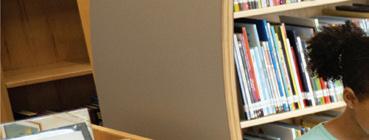


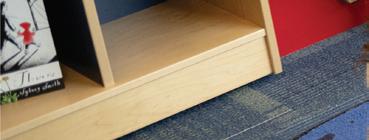




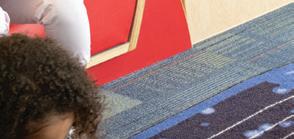


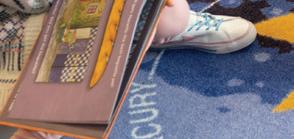


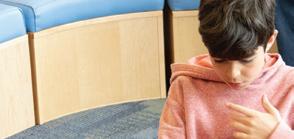



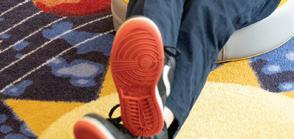



“Demco has been a great partner in working with us on delivery times and installation to have our schools open on time.”
“Demco has been just a great match for our district — collaborative, fun, and a great partner. They really care about the district and the people they work with.”
“The whole design and furniture selection process, as well as installation, has been wonderful through all of our projects.”
Je Mann

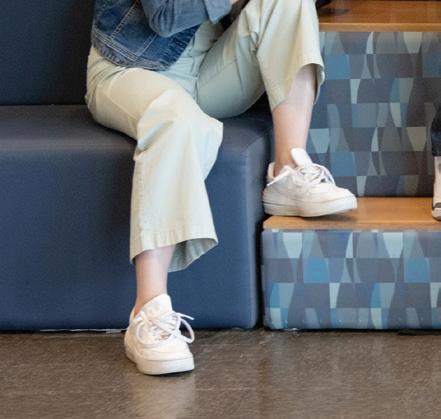
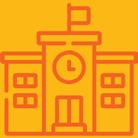
4 years, 5 projects, 7 schools







13,000+ pieces of furniture installed Punch list* installation rate 2x better than the industry average

Demco installation team on site approx. 5,000 hours, 30+ days








The customized system adjusts to your dynamic environment.




